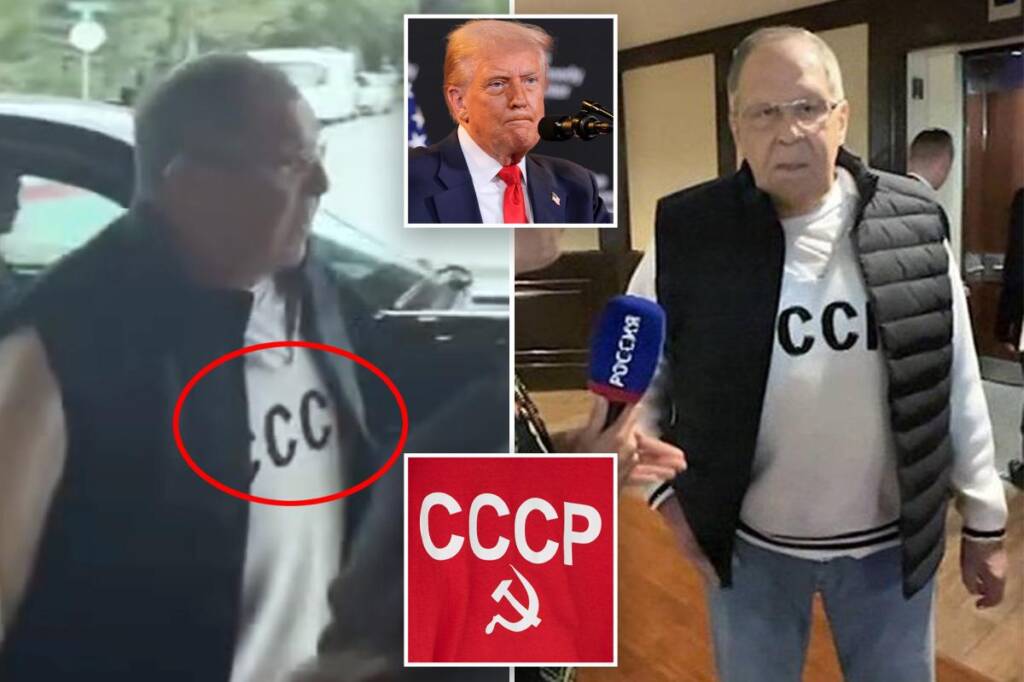It is said, that in diplomacy everything is completely deliberate, every word every statement, every move, as it has implications far beyond the internal politics of a nation.
Now Russian Foreign Minister Sergey Lavrov has sparked global controversy this week after arriving in Anchorage, Alaska, for a high-stakes summit while wearing a sweatshirt emblazoned with “CCCP,” the Cyrillic abbreviation for the former Soviet Union.
The moment, caught on camera, immediately went viral fueling speculation that the gesture was more than just an eccentric fashion choice.
With the backdrop of the ongoing war in Ukraine and heightened East-West tensions, Lavrov’s wardrobe has now become a focal point of debate among diplomats, analysts, and political observers. Was this a signal of Moscow’s imperial ambitions, a diplomatic provocation, or mere trolling?
Lavrov’s appearance in Soviet-era garb had now been widely interpreted as a deliberate symbolic gesture rather than an oversight. Former Swedish Prime Minister Carl Bildt commented, “He wouldn’t do this just by chance,” while retired U.S. Lt. Gen. Ben Hodges said it signaled that Russia was taking the talks “seriously—but not in terms of achieving a peaceful settlement.”
The message was clear to many: Russia is not backing away from its narrative of regional dominance and is instead doubling down on its nostalgic, imperialist messaging.
Soviet Nostalgia Meets Geopolitical Messaging
Wearing the USSR logo—particularly at a summit hosted by the United States—evokes deep historical and political symbolism. It directly appeals to a narrative pushed by Russian President Vladimir Putin, who has famously called the Soviet Union’s collapse “the greatest geopolitical catastrophe of the 20th century.”
To Kremlin critics, this gesture was a bold visual cue reinforcing that narrative. It plays into the ongoing rhetoric that Russians and Ukrainians are “one people,” and suggests that Moscow still views large parts of the former Soviet bloc, especially Ukraine, as within its sphere of rightful control.
Some observers saw Lavrov’s sweatshirt not only as an homage to the USSR but also as a calculated affront to Ukraine’s sovereignty. Former Lithuanian Foreign Minister Gabrielius Landsbergis posted a sarcastic response on social media:
“’Just give us half of Ukraine and we promise we will stop,’ says negotiator wearing USSR sweatshirt.”
Such statements echo a broader concern in the West: that Russia is using every diplomatic opportunity to showcase their reach far beyond Ukraine hinting at its revanchist ambitions.
Distraction or a signal of Soviet Return
Russia has long employed symbolic trolling as a diplomatic tactic, and Lavrov’s outfit appears to follow that tradition. Reports suggest Russian delegates on their flight to the summit were served “Chicken Kyiv,” an intentional jab referencing Ukraine’s capital.
Former U.S. Ambassador to Russia Michael McFaul characterized the stunt as “trolling Trump,” suggesting Lavrov’s outfit was aimed less at building consensus and more at shaping headlines and optics.
When questioned, Lavrov denied any deeper meaning behind his clothing, telling Russian media that Moscow came to the talks with “clear arguments and a firm position.” But few international observers bought the explanation.
Given the intense symbolism associated with the Soviet Union, it’s unlikely that a seasoned diplomat like Lavrov would wear such a politically charged item without intent especially at a meeting with global consequences.
Whether viewed as a stunt, a provocation, or a declaration of ideological and imperial continuity, Lavrov’s choice to wear a USSR sweatshirt on U.S. soil cannot be dismissed as apolitical. In today’s era of image-driven diplomacy, such choices are messages in themselves—ones that speak volumes about Russia’s posture and ambitions on the world stage.
While no formal statement was made about reviving Soviet territory, the symbolic power of Lavrov’s attire left little doubt. Putin and Russia’s vision of its former territorial and power revival may continue to shape its strategy for the world’s geostrategic future.
